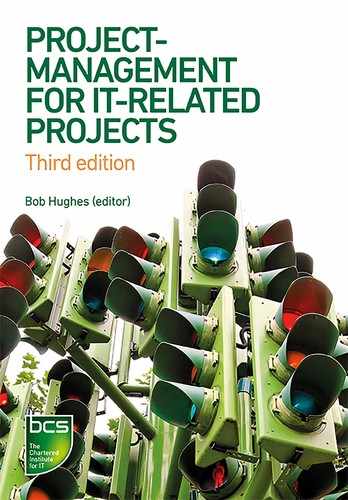0%
22Chapters
0-1Hours read
0kTotal Words
Table of Contents
- Front Cover
- Half-Title Page
- BCS, THE CHARTERED INSTITUTE FOR IT
- Title Page
- Copyright Page
- Contents
- Figures and tables
- Useful websites
- Acknowledgements
- Preface
- 1. PROJECTS AND PROJECT WORK
- Learning outcomes
- 1.1 Projects
- 1.2 Successful projects
- 1.3 Project management
- 1.4 System development life cycle
- 1.5 Project management and the development life cycle
- 1.6 Elements of project management
- 1.7 Development process models
- 1.8 Project plans
- 1.9 The business case and benefits management
- 1.10 Transition strategies
- 1.11 Post-implementation review
- Sample questions
- Pointers for activities
- 2. PROJECT PLANNING
- 3. MONITORING AND CONTROL
- 4. CHANGE CONTROL AND CONFIGURATION MANAGEMENT
- 5. QUALITY
- 6. ESTIMATING
- 7. RISK
- Learning outcomes
- 7.1 Introduction
- 7.2 Risk management
- 7.3 Identifying risks
- 7.4 Assessing the risk
- 7.5 Quantitative approaches to risk
- 7.6 The qualitative approach to project risk assessment
- 7.7 Deciding the appropriate actions
- 7.8 Planning, monitoring and control
- 7.9 Summary
- Sample questions
- Pointers for activities
- 8. PROJECT ORGANISATION
- Learning outcomes
- 8.1 Introduction
- 8.2 Programmes and projects
- 8.3 Identifying stakeholders and their concerns
- 8.4 The organisational framework
- 8.5 Desirable characteristics of a project manager
- 8.6 Project support and management offices
- 8.7 Project team
- 8.8 Matrix management
- 8.9 Team building
- 8.10 Team dynamics
- 8.11 Management styles
- 8.12 Communication methods
- 8.13 Conclusion
- Sample questions
- Pointers for activities
- Answers to sample questions
- Bibliography
- Index
- Back Cover
